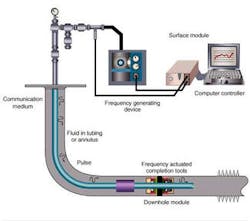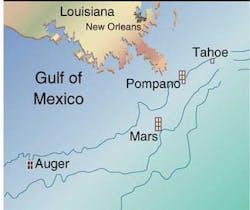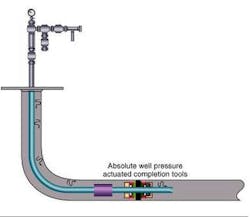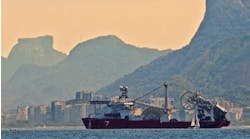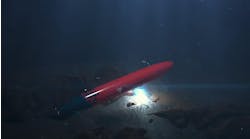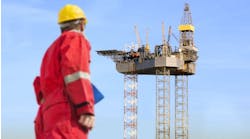Remote actuation systems for setting completion tools work at ultra-depths
A common conventional completion practice in well construction is to set a retrievable or permanent production packer to isolate and control pressure and fluids from the producing zone. To enhance efficiency, the preferred packer setting method is a one-trip hydraulic system. The packer is run in on the production string in a single trip. The tubing is plugged by landing a wireline or coiled tubing-conveyed blanking plug into a seating nipple below the packer. The packer is then set using hydraulic pressure. The one-trip hydraulic system requires well intervention, which can consume from 12 hours to two days of rig time, and introduces the risk of losing the wireline or coiled tubing and associated tools in the well.
A more fit-for-purpose setting system would include all the features of the existing one-trip hydraulic system, but would eliminate both the need to plug the tubing and the associated well intervention. These capabilities currently exist in two innovative, one-trip, remotely actuated, hydrostatic-set completion systems. One of these systems relies on pressure-pulse communication for actuation; the other relies on absolute well pressure. Both are currently being used in the Gulf of Mexico, the Atlantic Frontier, the North Sea, and southern Argentina; other wells are scheduled for completion in Brazil and the Philippines.
Pressure-pulse telemetry
The pressure-pulse, wireless and control line-less, remote actuation system is based on one-way fluid-conveyed communication. The system consists of a surface module, a communication medium, which is the fluid column in the completion string, and a downhole completion device (packer). The surface module's function is to transmit a preprogrammed frequency of pressure pulses. The fluid column carries the pulses to the electronically enhanced packer or other completion device, which is preprogrammed to actuate upon receiving the correct frequency of pulses. Pulses may be transmitted through the tubing or the annulus.
The surface module consists of a computer controller, an interface box with manual controls, and a computer-controlled pulse-generating unit. The pulse-generating unit transmits a discreet pressure pulse of specific amplitude and frequency through the tubing fluid. Its components include two piston accumulators, an air-driven water pump, and two pneumatic actuator-operated valves that control discharge of fluid into and out of the well. The surface unit also includes gages that monitor the charging of the accumulators, and bleeder valves that purge air from the system. The interface system is manual. The frequency of the pulse transmission is automatically controlled through a laptop computer.
The downhole module consists of an electronically enhanced packer fitted with a frequency detector, an onboard electronic controller, an electromechanical actuator, and a battery power pack. The frequency detector, which is mounted on the packer's body, constantly measures pulses traveling through the fluid column. The onboard electronic controller is preprogrammed to register the pressure pulses. When the controller acknowledges receipt of the proper profile and frequency of pulses, a preprogrammed time delay begins. After the time delay, the electromechanical actuator receives power from the battery pack and sets the packer via hydrostatic pressure.
Operational procedures
Just before the packer (or other electronically enhanced completion tool) is run in the well, it is checked and preprogrammed with a hand-held terminal to:
- Recognize a discreet pulse frequency
- Actuate after a predetermined time delay.
As the completion is run, the surface module's computer controller is preprogrammed to transmit the discreet pulse frequency, and the surface system is primed so the only additional time spent is in connecting hoses for transmission of pulses through the fluid column. Once in the wellbore, the downhole tool's receiver constantly samples all pulses traveling through the completion fluid, while its control system filters and recognizes only pulses of a predetermined profile and amplitude. The tool will not actuate until the preprogrammed discrete frequency is matched.
Once the completion system reaches setting depth, the well can be circulated with the desired completion fluid. Generally, before the matching pulse frequency is sent, a single pressure-pulse is transmitted through the fluid column. The reflected pulse received at surface is recorded via the laptop computer's data acquisition system. This "test pulse" allows the user to assess, in real time, the quality of pulses delivered, and therefore ensures that effective communication is established between the surface system and the downhole tools.
Following the communication check, the pressure-pulse generating process proceeds automatically, under the computer's control. After the matching frequency has been sent, received, and confirmed by the control system of the downhole tool, and the preprogrammed time delay has occurred, the tool sets.
Should the laptop computer system fail to send the matching frequency, the actuator may be controlled manually.
Should the primary actuator fail to set the completion tool, secondary actuation is achievable through conventional rig intervention methods. This secondary actuation method for the packer requires landing a blanking plug on wireline in the tubing below the packer and applying hydraulic pressure.
Run history
Previous literature on pressure-pulse remote actuation of completion tools introduced this innovative technology to the industry and documented case studies to support its continued use. The Gulf of Mexico has seen continuous use of pressure-pulse-telemetry-actuated equipment since 1996, when the technology was first introduced on Shell Mars Subsea #4. This completion was performed in 2,940 ft water depth, at a working depth of 16,894 ft.
During the prior 12 months, a total of 12 pressure-pulse-telemetry-enhanced packers were run in Gulf of Mexico deepwater in five separate fields. These packers were used exclusively in water depths up to 3,800 ft, and hydrostatic pressures exceeding 11,000 psi. Previous pressure-pulse-telemetry operations lowered packer setting time to just over an hour. But, by rigging up the surface equipment while running the packer in the hole, the average total elapsed time to transmit and receive the pressure pulse signal and set each of the packers was just 15 minutes.
Managing time in this manner moves well operations toward the technical time limit of well completion efficiency. In these wells, the alternate process of running, setting, and retrieving a wireline- or coiled tubing-conveyed blanking plug to a seating nipple below the packer requires several hours. The primary cost saving from this technology is direct rig time reduction. However, additional economic benefits accrue from avoiding costs associated with intervention.
Pressure-pulse remote actuation systems have operated with a 92% success rate during the 12-month time frame covered by this paper. One of the packers had to be set by the contingency setting method described above because failure of other equipment in the well prevented reception of the pressure pulse signal.
Pressure-pulse telemetry technology has also been used successfully in record-setting extended reach drilling (ERD) applications. In wells off the coast of Tierra del Fuego, Argentina, packers have been set at measured depths up to 26,450 ft. The success rate of this technology in ERD applications is 100%.
Absolute pressure actuation
Absolute well pressure activation is less complex than the pressure-pulse telemetry communication system. The concept of actuating devices using absolute well pressure is commonplace in other phases of well construction, particularly in drill stem testing and perforating equipment. Such tools hold atmospheric air pressure in a chamber as they are run to depth and use a rupture disc for actuation.
When the absolute pressure in the well exceeds the differential pressure rating of the rupture disc, the disc ruptures, allowing wellbore fluid into the tool. The pressure difference between the wellbore pressure and the atmospheric chamber provides the driving force for setting the tool.
The packer is made up and run in the hole in exactly the same manner as a conventional hydraulic set packer in a one-trip completion. Once the completion system reaches setting depth, the well can be circulated with the desired completion fluid. Pressure in the wellbore is then increased to the point where the pressure ruptures the disc, actuating the packer.
The packer is completely packed off by the hydrostatic pressure of the well. It is important to take into consideration that the tool is actuated by absolute well pressure, and that at any time when the pressure in the wellbore exceeds the rupture disc rating, the packer will set. For example, if the fluid in the well at the time the packer is initially run has a higher weight than the completion fluid, the rupture disc must be selected with respect to the more dense fluid.
Absolute well pressure actuation systems have resulted in dramatic savings for operators in the Atlantic's northern frontier, which claims some of the world's harshest drilling conditions. BP's Schiehallion and Foinaven oil fields, for example, are benign shallow reservoirs, but lie in a harsh subsea environment, in water depths from 1,150 ft to 1,800 ft. As many as three fourth-generation semisubmersible rigs have operated year-round, since development drilling began in the area in 1995.
Rig time
With operating costs approaching US$250,000 per day per rig, the major part of well cost is rig time. Thus, savings in rig time represents significant cost savings. High-angle and extended-reach wells are common in this area, often putting completion packers beyond wireline access. Early completions in the Foinaven and Schiehallion fields relied extensively on coiled tubing operations to run and pull plugs as part of completion installation.
As a result, completion operations often suffered from non-productive time and waiting on weather associated with the coiled tubing work. Completions typically required approximately 15 days, excluding installation of the subsea tree. A system that allowed completion without coiled tubing intervention was sought for desired cost savings.
The selection of absolute well pressure-activated tools for these completions in 1998 was driven by the simplicity of the tools and an appropriate well design that featured a cemented liner or liner top isolation valve. These completions were the first ever to use absolute well pressure activation on a completion packer.
Since the introduction of this technology, the run history in these fields has been unquestionably successful. To date, 14 tools have been run without failure. Twenty-seven absolute well pressure-activated tools have been run worldwide. And, more work is scheduled in South America and the Philippines later this year. The cost saving realized by adopting remotely actuated completions is almost US$1 million per well in some wells. A considerable part of those saving results from eliminating coiled tubing operations; routinely, coiled tubing has ceased to be mobilized to the rig, as this type of completion has gained acceptance.
Conclusions
Remotely actuated packers have a proven run history in some of the harshest and most remote working environments throughout the world, including the North Sea, North Atlantic, and Tierra del Fuego, Argentina. Pressure-pulse-telemetry-activated tools can be used in wells that will support a full column of fluid, and absolute-well-pressure-activated tools can be used in wells with an unperforated liner or liner top isolation valve.
Rig time associated with wireline and coiled tubing intervention to set completion packers can largely be eliminated through the use of remotely actuated packers. Value is added to the completion phase of well construction by decreasing operational complexity of the completion and thus reducing risks associated with safety and environmental, waiting on weather, and non-productive time.
Acknowledgment
Baker Oil Tools granted permission to publish this paper. Shell, BP, TotalFinaElf, and other operators have provided funding for remotely actuated packer research.
Editor's Note: This is an updated and summarized version of SPE 68763, which was presented at the SPE Asia Pacific Oil and Gas Conference and Exhibition, Jakarta, Indonesia, April 17-19, 2001.
